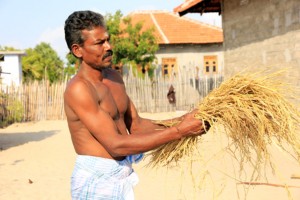Stories from the Field: Rebuilding Homes in Conflict Affected Jaffna District

Mr.Veluppillai Sivarasa is a toddy tapper and farmer from Jaffna.
Mr.Vellupillai Sivarasa is a farmer and toddy tapper from Jaffna district. In February 2014, he moved into his new house, constructed with funding from the Indian Housing Project. Using the grant of LKR. 550,000 provided by the Government of India, Sivarasa managed to complete the house construction within seven months. His family is now enjoying the benefits of a permanent home after many years of displacement and uncertainty.
Forty four year old Sivarasa and his wife Ushananthani live in Ampan village in Jaffna district with their six children. The eldest son Banushan earns a living as a daily wage labourer. Four of their children attend the American Mission Tamil Mixed School in Ampan, walking the short distance to attend their lessons. Their 16 year old daughter, Pavithira, has left school and is helping her parents with their livelihood activities.

The Sivarasa family outside their temporary shelter.
The Sivarasa family, like thousands of others in the North, were displaced by the protracted conflict in Sri Lanka. In 1996, with the intensification of hostilities in the Jaffna district, the family moved to Kilinochchi, where they lived for over 12 years. With the end of the conflict in May 2009, Sivarasa returned to Jaffna later the same year with his family. However, they found their family home damaged beyond repair, requiring a complete rebuild.
By making toddy with palmyrah fruits and cultivating a half acre of paddy land, Sivarasa earns about LKR.7,000 per month. However, this was not enough to build a permanent house to replace their damaged home. As the couple had no savings, they had little choice but to live with friends in the neighbourhood until they could find adequate finances to build their own house. In 2011, with assistance from UNHCR, Sivarasa built a temporary shelter using tin sheets, cadjan and tarpaulin. Although the family was happy to have their own living space, their shelter didn’t have enough facilities, especially for their young, school going children.

House construction in progress at wall plate level.
In May 2014, Sivarasa was selected as a beneficiary for housing support by the Indian Housing Project. He received the first grant instalment of LKR.100,000 in June 2014 and started construction. This was a joyful day for the entire family. As the project followed a “homeowner driven” method of construction, Sivarasa and his wife were jointly responsible for planning, designing, organizing and constructing their house. The implementing agency, UN-Habitat, helped the family select a suitable house plan and provided advice on construction methods, disaster risk reduction features, selecting quality building materials and hiring skilled workers. Sivarasa hired two masons and a carpenter for skilled construction work components while the older family members contributed their labour by helping with the unskilled masonry and carpentry work.
The Sivarasa family were also fortunate to have their own regular water supply through a dug well in their garden. Water from the well was used for house construction activities as well as daily needs including cooking and washing.
Their completed 550 square feet house consists of a living room, two bedrooms, a kitchen and a sanitary toilet. It has been constructed using cement blocks for walls, clay roofing tiles and Palmyrah timber for the roof structure. Mahogany timber has been used for the majority of doors and windows while timber from the Neem tree has been used for the shrine room. The family also saved money by producing their own cement blocks using a mould provided by UN-Habitat to beneficiary families in the village. Training on cement block production was provided by the UN-Habitat technical team to all homeowners.

Sivarasa family outside their new permanent home.
Disaster Risk Reduction (DRR) features have been incorporated into the house design in order to withstand extreme weather conditions. 150mm thick blocks have been used to build external walls tied with a reinforced concrete ring beam at lintel level. The hipped roof has been anchored to the ring beam and mortar restraining bands have been incorporated over the tile roof to resist high winds. In addition, raising the foundation above the annual flood level will prevent flood damage during the monsoon rains.
Mrs. Ushananthini Sivarasa, discussing the benefits of the Indian Housing Project, said “Many families in our village who had no money to build permanent houses have been supported by this project. On behalf my family, I want to thank everyone who helped us to build this beautiful house.”
“We feel so much safer in our permanent house. It has given our family much needed privacy and security. My children are so much happier since we moved as they have enough space to study” Mr. Sivarasa stated.
With the completion of construction in February 2015, the family moved to their house on 2nd February 2015, an auspicious day for the family. Their temporary shelter is now used as an alternate kitchen where non vegetarian meals are prepared. The family is now gradually extending the house by building a front verandah with their savings.
The Indian Housing Project (IHP) is a housing reconstruction project funded by the Government of India and implemented through a Memorandum of Understanding with the Government of Sri Lanka. This 42 month project is implemented through a homeowner driven process. UN-Habitat will support 18,000 families to construct permanent homes in Kilinochchi, Mullaitivu and Jaffna districts under this project.
